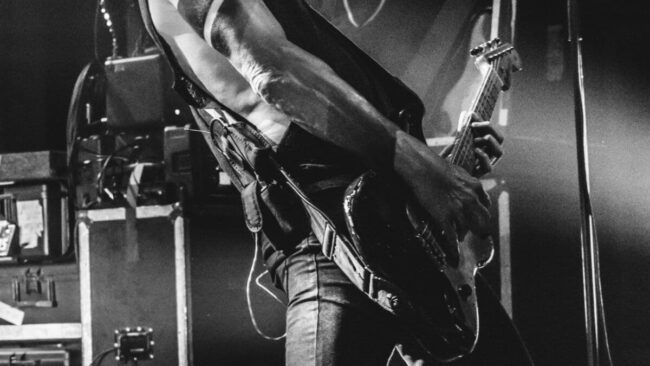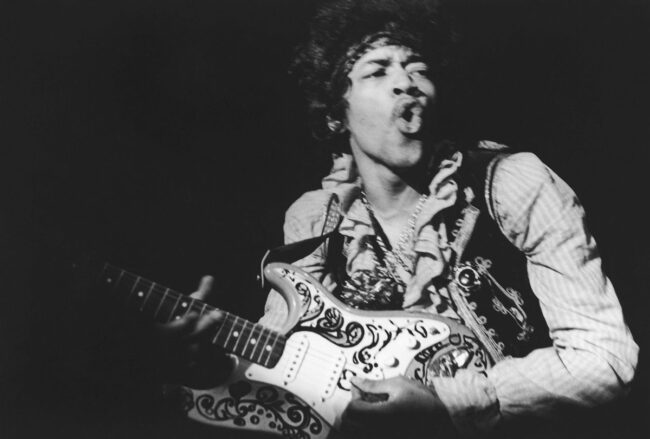Great guitar riffs grab listeners within seconds. They command attention and drive songs forward with memorable melodic power. These iconic musical moments aren’t just notes on a fretboard. They become unforgettable surges of adrenaline that get burned into our collective memory.
In fact, the greatest guitar riffs of all time stand out because they know how to say so much through simplicity. Chuck Berry’s double-stop intro on “Johnny B. Goode” (maybe the most stolen lick in history) and Green Day’s “When I Come Around” (their highest-charting radio single for a decade) show how the most recognizable guitar riffs keep inspiring generations of musicians. These musical hooks grab listeners by the ears and just need attention, creating strong emotional responses that exceed time.
Let’s get into the techniques, stories, and magic behind rock’s most unforgettable six-string moments in this piece. We’ll break down eight of the most influential examples and guide guitarists who want to master these cornerstone pieces of musical history.
What Makes a Guitar Riff Iconic?

A guitar riff is more than just a sequence of notes—it’s a musical statement that captures a song’s essence. These short, catchy musical phrases stick out and become the most memorable parts of legendary tracks. They work as hooks and foundations at the same time.
Memorability and repetition
Repetition is the life-blood of any iconic guitar riff. Musical phrases show up multiple times throughout a song and create a familiar feeling that listeners grab onto.
This repetitive quality acts as a musical anchor that gives audiences something solid to connect with every time they hear the song. Simple note sequences turn into unforgettable hooks that stay stuck in your head.
The most famous guitar riffs have one thing in common: melodic catchiness. This makes them easy to remember and hum, even if you’re not a musician.
The opening notes of “Smoke on the Water” or “Sweet Child O’ Mine” jump out after just a few notes. These riffs stick in your mind because they’re simple and distinctive.
Great riffs have a unique quality that makes them stand out in the musical world. They become one with the songs—you can identify the track just by hearing the riff. This distinctive nature raises certain guitar riffs from good to truly iconic.
Emotional tone and energy

Each great guitar riff has its own emotional fingerprint. Raw energy flows through hard rock riffs while bluesy passages carry melancholic beauty.
These musical phrases pack emotions with amazing efficiency. Guitar riffs improve the overall listening experience by adding complex layers and emotional depth to songs.
The rhythmic qualities of riffs pack quite a punch. Many of the best guitar riffs of all time create a groove that gets people moving—feet tap, heads bob, bodies sway.
This rhythmic pulse makes riffs so captivating and energetic. A well-crafted riff pushes songs forward with momentum that carries listeners through the musical experience.
The riff’s emotional impact grows stronger with context—crowd energy, band chemistry, and atmosphere all add to the emotional story. A heartfelt riff speaks volumes without words and creates an emotional connection that exceeds language barriers.
Placement in the song (intro vs. chorus)
Strategic riff placement throughout a song shapes its impact and purpose. Greatest guitar intros often showcase signature riffs that set the song’s identity right away.
These opening statements grab attention instantly—guitarists like Billy Corgan of The Smashing Pumpkins know a great intro riff reshapes a song’s character completely.
Rock subgenres often use riffs as their foundation. Verse riffs provide solid ground for other elements to build upon. Chorus riffs become high points that listeners wait for throughout the song.
Riffs also launch amazing guitar solos. The main riff gives structure for guitarists to show off their skills while keeping the song’s identity intact. This connection between riff and solo tells a satisfying musical story within the bigger piece.
Guitar riffs can be melodic, rhythmic, or aggressive. Musicians use this flexibility to express different emotions and energy levels based on their placement in the song structure. That’s why the most recognizable guitar riffs have become lasting pieces of musical history.
Anatomy of the Greatest Guitar Riffs

Let’s examine what makes the most famous guitar riffs tick. These riffs blend musical elements that create pure sonic magic. The right mix of components explains why some riffs stick around for decades while others just fade away.
Rhythm and groove
A killer guitar riff needs rhythm at its core. The best riffs start with a unique rhythmic pattern that gives them personality. This rhythm often stands alone before other instruments jump in and sets the song’s whole vibe. Many legendary riffs actually lean more on their rhythm than their melody.
Syncopation puts the punch on unexpected beats and turns good riffs into unforgettable ones. This trick builds tension and excitement that keeps people hooked. Smart use of syncopation gives riffs their attitude and makes them stand out instantly.
The groove factor packs a serious punch. From James Brown to John Scofield, groove-based music needs a tight rhythm section. The best guitar riffs sync perfectly with the drums, especially the kick and snare. When guitars and drums lock together, they create that infectious quality that gets everyone moving.
Melodic hooks

Rhythm builds the foundation, but melody brings the emotional punch and staying power. Legendary riffs pack melodic elements you can hum or whistle—musicians call this the “whistle test.” A riff that passes this test usually has strong melodic appeal.
Greatest guitar intros pack simple yet distinctive melodies that grab you right away. These melodic hooks hit you in the feels and connect instantly with listeners. Simple melodies often work better than complex ones.
Classic riffs usually skip big jumps or weird intervals. They stick to patterns that feel natural and right. This makes them easy to remember, even for people who don’t play music.
Tone and gear choices
A riff’s sound matters just as much as its notes. Your gear choices—guitars, amps, pedals—shape the riff’s personality. The Kinks’ “You Really Got Me” shows this perfectly. Dave Davies slashed his amp’s speaker with a razor blade to get that fuzzy, distorted tone that made the riff iconic.
Tone settings make a huge difference in how people hear a riff. Treble creates sharp, crisp sounds. Mid settings can flip a sound’s character completely—less mids give you that classic ’80s “scooped” sound, while more mids create a “honky” tone.
Palm muting adds punch to the groove. Effects like fuzz, delay, and compression turn basic notes into powerful statements. The most recognizable guitar riffs often come with signature tones that define their sound.
Repetition vs. variation

Great riffs need the right balance between repetition and change. Repetition helps people catch onto a riff and expect what’s coming. Too much of it gets boring fast.
Smart variations solve this problem. Small changes keep the riff’s identity but make it interesting. AC/DC’s “Back in Black” shows this beautifully. The riff repeats throughout but changes slightly in rhythm and dynamics to stay fresh. Tiny tweaks in notes, rhythm, or volume keep listeners hooked.
Some songs with best guitar riffs develop their ideas throughout the song. They might add new elements, change the harmony, or expand the melody while keeping the core idea. This growth keeps the riff exciting from start to finish.
8 Songs with the Best Guitar Riffs Ever
These eight guitar riffs showcase rock’s finest six-string artistry. Each riff has earned its legendary status through distinctive character, technical breakthroughs, and how it changed music culture.
-
Whole Lotta Love – Led Zeppelin
Jimmy Page created a riff that changed rock history on “Led Zeppelin II” in 1969. This brutally simple pattern starts on the “and” of the third beat and creates instant rhythmic tension.
The riff gets its power from careful palm muting with the right hand, attention to the slide on the B note of the low E string, and quarter-tone bends on the A string. Van Halen and Aerosmith drew inspiration from this groundbreaking sound.
-
Smoke on the Water – Deep Purple
Total Guitar magazine ranked Ritchie Blackmore’s monumental riff as the fourth greatest guitar riff of all time. Blackmore admits the riff comes from his take on Beethoven’s Symphony No. 5, joking that he “owes him a lot of money.” Beginners love this pattern for its simplicity, yet it remains eternally powerful.
-
Johnny B. Goode – Chuck Berry
Berry’s “Berry on Top” album from 1958 gave us what might be the most influential guitar-driven intro ever made. His double-stop technique and rhythmic breakthroughs created a blueprint that rock guitarists would follow for decades.
-
Sweet Child O’ Mine – Guns N’ Roses
Slash crafted a serpentine opening riff with a distinctive pattern on the B and high E strings. The melody dances between the 14th, 13th, and 11th frets in D major, creating an unforgettable tune that perfectly contrasts with the song’s heavier sections.
-
Day Tripper – The Beatles
The Fab Four’s classic opens with a motif on the D and A strings, featuring a memorable slide from the 4th to the 2nd fret. This riff blends blues influence with pop sensibility, showing why The Beatles excelled across multiple genres.
-
Back in Black – AC/DC
AC/DC’s tribute to their late singer Bon Scott starts with Angus Young’s precise mix of chunky power chords and crisp single notes. His rhythmic precision and dynamic control set up the perfect foundation for Brian Johnson’s vocals, creating one of rock’s most iconic intros.
-
Layla – Derek & The Dominos
Eric Clapton mixed single-note runs with moving chord patterns in this classic riff. Players typically use a Strat-style guitar through a cranked Tweed amp, and the riff needs skilled hammer-ons and pull-offs. The unexpected entry on the “and” of the third beat hooks listeners right away.
-
I can’t get no satisfaction – The Rolling Stones
Keith Richards created a revolutionary sound with his three-note riff using the Maestro FZ-1 Fuzz-Tone pedal. The riff stays on the A string, moving from the 2nd fret up to the 5th and back down. This proves that perfect execution of a simple idea creates timeless music.
Techniques Behind the Most Recognizable Guitar Riffs
Raw talent alone doesn’t create the most recognizable guitar riffs. Skilled guitarists use specific techniques to craft memorable musical statements that turn simple note sequences into timeless hooks. These hooks define songs and genres.
Using pentatonic and blues scales
Pentatonic and blues scales are the foundations of countless classic riffs. These six-note progressions feel right at home in blues, rock, and country music. Blues scales add one chromatic note (the “blue note”) to the pentatonic scale. This addition creates that unmistakable bluesy sound behind many of rock’s greatest moments.
Major and minor pentatonic scales create core sounds in different settings. Minor pentatonic scales deliver the edge and tension needed for blues and rock.
Major pentatonic adds warmth but lacks sufficient bite when used by itself. Guitarists often combine both scales to keep the minor pentatonic’s grit while adding the major pentatonic’s melodic possibilities.
Creating tension with syncopation

Syncopation turns ordinary riffs into extraordinary ones by stressing weak beats and temporarily displacing the regular beat.
This technique creates unexpected rhythmic patterns that catch listeners’ attention by challenging their expectations. Guitarists call each syncopation “a temptation for acceleration.” Players need careful control to keep steady timing.
Strategic use of syncopated notes adds swagger and attitude to iconic riffs. “Sweet Child O’ Mine” shows this with its serpentine opening pattern that draws power from rhythmic displacement. “Whole Lotta Love” starts on the “and” of beat three, which sets up rhythmic tension right away.
Layering with rhythm and lead
The best guitar riffs of all time shine through the interplay between rhythm and lead guitar parts. Smart frequency spectrum allocation prevents muddiness. Rhythm guitars usually take mid-range frequencies, leaving space for lead guitar to cut through.
Volume balance plays a crucial role in layering guitars. Great mixes put the most important guitars up front with supporting guitars sitting 1-3dB lower in volume. This careful arrangement lets lead parts stand out while rhythm guitars provide solid backing.
Using effects like fuzz and delay
Effects pedals have shaped the character of the greatest guitar intros. Keith Richards revolutionized guitar sound with the Maestro FZ-1 Fuzz-Tone on “Satisfaction.” Brian May turned his guitar into a self-responding orchestra through Echoplex’d repeats as counterpoint melodies in “Brighton Rock.”
Each effect creates its own sonic signature. The Cure’s songs feature atmospheric intros with flangers. Talk boxes let guitars “speak” through the guitarist’s mouth. Simple notes become powerful statements through careful use of reverb, delay, and distortion. These effects become part of each riff’s identity.
How to Learn and Master These Riffs

Learning iconic guitar riffs needs smart practice techniques beyond simple repetition. Guitar players at all levels go back to these basic methods when they learn new material, whatever their expertise.
Start slow and use a metronome
Your accuracy matters more than speed. Playing at a comfortable tempo lets your fingers build proper muscle memory without mistakes.
The original metronome setting should be at a moderate tempo where you nail the riff perfectly. You can increase the BPM as you become more confident. Playing at very slow speeds can be tougher than fast ones. Slow tempos make timing errors stand out more clearly.
Accent features on metronomes help you spot the first beat of each measure so you don’t lose your place. Regular metronome practice builds your internal rhythm sense. Soon you’ll keep steady timing even without the click track.
Break the riff into smaller parts

Complex riffs become easier when you split them into small sections of 2-3 notes. This way prevents you from feeling overwhelmed and lets you zero in on tricky transitions. String-skipping patterns need special attention. Practice these specific moves by themselves before you try the whole sequence.
The quickest way to success is mastering one phrase at a time before connecting them. Most guitarists look for natural breaks in solos and riffs. They notice when sections repeat with small changes.
Focus on tone and dynamics
Great guitarists stand out through their control of dynamics—how loud or soft each note sounds. Small changes in your picking strength can change your tone dramatically. Picking harder brings out more distortion and harmonics. The right accent notes make riffs come alive and create an emotional punch beyond the notes themselves.
Practice with backing tracks
Backing tracks create perfect environments to practice without stress. They never get tired or bored like other musicians, so you can repeat sections endlessly. These tracks help develop vital timing skills and give you a tonal center that makes scale relationships click.
Look for tracks that match where you are in your learning journey. As your skills grow, try different tempos, keys, and progressions. This builds both your technical ability and musical understanding. Mechanical exercises transform into real musical expression.
Conclusion

Guitar riffs are the life-blood of rock music history. They define generations and create instant recognition in a variety of audiences. These musical moments surpass mere notes on a fretboard and become cultural touchstones that appeal decades after their creation.
Great riffs share a common thread – simplicity. Keith Richards’ three-note pattern on “Satisfaction” shows how straightforward ideas can achieve musical immortality when executed perfectly.
Rhythm and syncopation turn simple melodic ideas into compelling hooks that grab listeners instantly. These simple patterns often hide considerable technical nuance.
Jimmy Page’s precise palm muting and Chuck Berry’s revolutionary double-stops represent state-of-the-art techniques disguised as accessibility.
Iconic riffs pack emotional power beyond technical complexity. The best guitar riffs create connections through knowing how to evoke immediate emotional responses. This explains why certain guitar patterns stay etched in our collective memory despite their simplicity.
New guitarists should build strong rhythmic foundations and memorable melodies before adding technical flourishes. Without doubt, the most recognizable guitar moments rely on strong melodic statements that anyone can hum after one listen.
Guitar riffs work as musical shorthand that communicate entire emotional landscapes through concise phrases. A perfect riff captures a song’s essence while standing independently as a musical statement.
Musical trends may change constantly, but a great guitar riff’s fundamental appeal remains unchanged. These sonic signatures captivate new generations of listeners and inspire countless musicians to pick up the instrument.
Players need patience, methodical practice, and attention to subtle details like tone and dynamics to master these iconic patterns. Simple-looking riffs hide nuances that demand careful study and dedicated practice. The rewards make the effort worthwhile – modern players connect to a rich musical heritage while building vital skills useful in any guitar style.
